
Stars & Stripes for a Razor-Sharp Italian
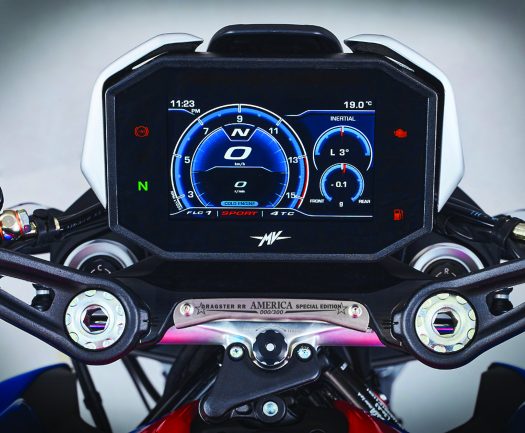
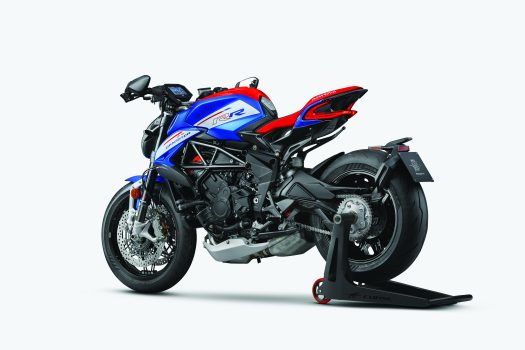
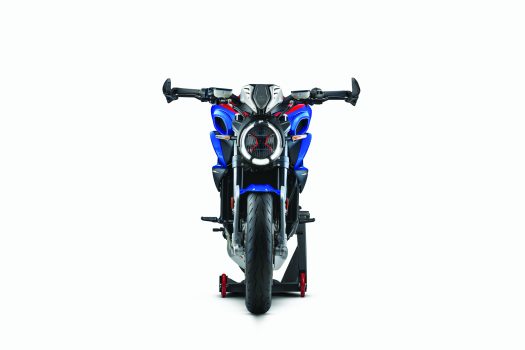
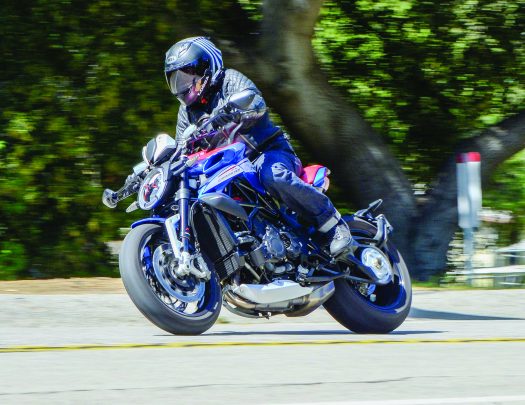
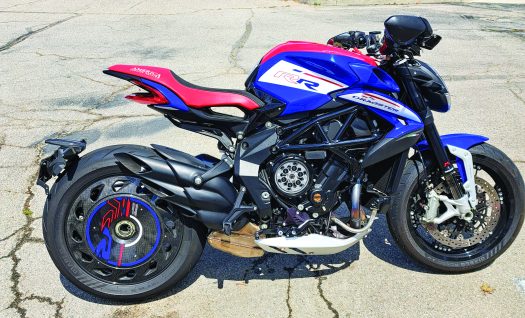
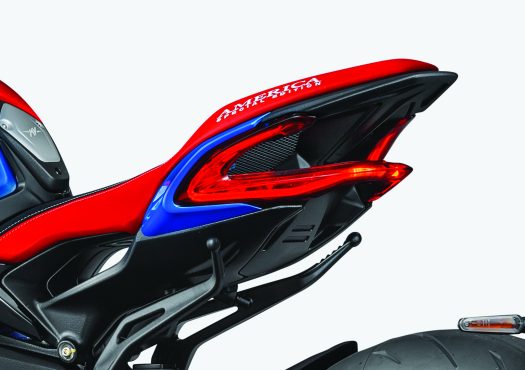
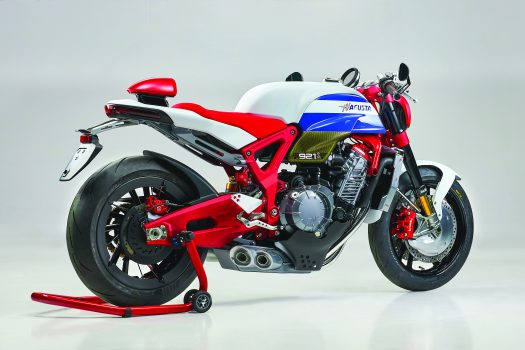
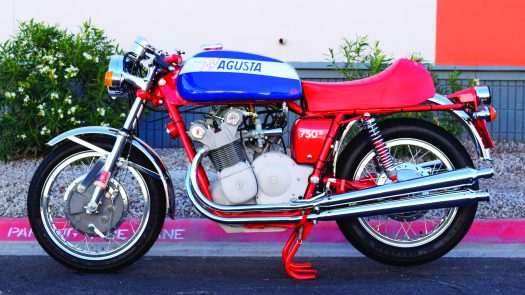
Story By Mike Seate and Jay LaRossa
Photos By Jose Gallina, MV Agusta and Mike Seate
Jose warned Jay and me that the new, 2024 MV Agusta Dragster RR SCS America was an attention-getter. As he wheeled it from the trailer at our test ride gathering spot, his words proved prophetic with passers-by asking, “What kind of bike is THAT?” Others noted its resemblance to something Evel Knievel would have ridden back in the ‘70s, or Captain America’s bike for the next Marvel “Avengers” movie. All of those observations are correct, but none do the 800c triple complete justice. It’s no overstatement to say the MV America is one of the most stunning two-wheeled conveyances ever built – by a mainstream motorcycle manufacturer, that is.
“I’ll bet it rips like crazy,” Jay said, swiping the triangular ignition key and pulling on his helmet. Having raced an MV Brutale for several years, Jay LaRossa is something of an expert on these exotic Italian speedsters. The 12-valve water-cooled engine is a raw mechanically noisy beast, ready to let loose with a bum-clenching level of torque at the merest whiff of the lightweight throttle. It’s also capable of hugging lines like Lewis Hamilton’s F1 Mercedes. Jay couldn’t agree more after his first loop through our favorite canyons.
“For some reason it feels together and more controlled than the 1000cc Brutale we tested last year,” he gushed. “I hit the gas pretty hard – enough for the front end to get light and make the bars wobble – and it still dropped into a corner like a bullet train. This thing is awesome.” In retrospect, the 190-horsepower liter-sized Brutale was just a bit too aggressive for the tight, twisty So Cal roads we prefer. However, the 140-horse 800 is blessed with the perfect level of arm-wrenching torque mated to a top end that makes the horizon rush forward at an insane-but-controllable rate.
The America has none of its bigger sibling’s cranky reluctance to potter through 35 MPH urban areas either. It’s light enough (at a claimed 385 pounds sans fuel and oil) to switch directions with bicycle-like ease. The SCS in its name represents the Smart Clutch System, an innovative slice of tech that allows riders to program away the responsibility of engaging the clutch at the handlebar lever. It’s an odd thing, but downshifting into first from a standstill with no clutch starts to grow on you after a bit. Still hatin’ on the clutch lever? Just engage the electronic quickshifter, which allows a full-on romp through all six evenly-spaced gears using just your left foot and the throttle as your guide.
There’s plenty more Buck Rogers tech, which helps justify the Dragster’s stratospheric $28,299 price tag. Wheelie control (trust us, you’ll need it) traction control with eight separate mapping options, a six-axis IMU, ABS and a full-color TFT dash with a very attractive circular tach display that makes flirting with the 13,000 redline a constant temptation are all on offer.
And you’ll be tempted like a medieval saint each time you hear the very mechanical engine clatter to life. Once the raspy three-cylinder idle evens out, it’s showtime, with the MV devouring corners hungrily. The seating position places the rider high into the wind, but the wide, flat tallish bars are such a welcome relief from the torturous low clip-ons of MV’s retro cafe Superveloce that the America feels like a sport-tourer by comparison. Like Triumph’s Speed Triple, this machine has several sweet spots where the reverse-direction crank smooths out engine vibes and makes you feel like you’re flying a WWII Spitfire; 70 MPH in fifth gear, 6,000 on the tach and the MV exemplifies what’s so special about Italian exotica. “Come on, throw me another fast, uphill sweeper,” your brain murmurs. We can handle it and more.” It’s worth noting that Jay weight a good 80 pounds less than me, but the firm suspension never needed its adjusters tampered with.
And then there’s the America’s looks. There are quite a few very attractive sporty motorcycles crowding showrooms these days, but few could be described as a pure styling exercise. This bike’s lengthy background dates back to the red, white and blue MV Agusta 750 America of 1973 (see sidebar) which, like this motorcycle, wasn’t to everyone’s tastes. However the ‘73 model soon developed a fanatical following and became an instant collector’s item. I suspect this MV, of which only 300 have been imported to these shores, will endure a similar fate. Museum-quality aesthetics abound, including the solid carbon rear wheel cover, the clear Lexan clutch cover that exposes the crank in feverish rotation, the downright sexy bodywork and the finish which is top-shelf all around.
It goes like stink, stops faster than your brain can process and turns like an electric dreidel. It’s also blingier then Flava Flav’s jewelry box, which means the Dragster America RR should easily find its home in the garages of high-earners everywhere.
Would we buy one? Well, for us poor print journos, 28K and change could buy a couple 1990s naked sportsters, a classic Britbike and still leave enough for a vacation to the Classic TT. But if you’re as wealthy as, say, Flava Flav, treat yourself. The MV Dragster America won’t disappoint. CR
2024 MV Agusta Dragster America RR SCS
MSRP: $28,299
Engine: 798cc inline triple with counter-rotating crankshaft
Transmission: Six-speed with hydraulic Smart Clutch System automatic shift and two-way quickshifter.
Brakes: Dual semi-floating 320mm rotors with radial Brembo four-piston calipers, front; Two-piston Brembo caliper with 220mm rotor; cornering ABS included.
Wheels and Tires: Six-spoke forged aluminum wheels with 17×200 rear Pirelli Diablo Rosso; 120/70×17 front.
Frame: Tubular steel with 55” wheelbase
Power: 140 horsepower @12,300 RPM; 64 foot-pounds of torque at 10,250 RPM
Fuel Capacity: 4.6 gallons
Electronics: Programmable traction control, four individual engine mapping options, cornering ABS, backlit handlebar switches, anti-wheelie software.
Weight: 385 pounds, dry.
Colors: Red, white and blue, baby!
We Dig: The sheer boldness and flawless museum-quality details and finish. The taillight is a work of art. Bellisimo!
We’d Ditch: The stock exhaust for the MV accessory Akrapovic muffler for eight extra ponies, please.
MV Agusta’s American Offerings
Back in 1973 stunt rider and orthopedic surgeon’s dream Evel Knievel was at the top of his bus-jumping game, and 27-time Grand Prix champion Giacomo Agostini had just recorded a Daytona 200 victory, and MV Agusta, Italy’s small-batch, high-performance motorcycle maker, was in a celebratory mood. Even though Ago’s Daytona win came aboard a Yamaha, he was closely associated with MV. It seemed the right time to release a version of their competition-proven double-overhead cam 750 in bold (some would say garish) red, white and blue livery. The inline four was definitely speedy for its time, capable of 135 MPH, even in street trim. Drum brakes, Ceriani forks and a then-astonishing $5,000 asking price kept this a rare machine on US roads. The relatively quick-revving engine’s DNA could be traced to the 500cc four designed by former Gilera engineer Piero Remor way back in 1952. The design proved to have some seriously long legs, responding well to displacement increases and various carburetor and intake tuning tricks. Want one today? Find one at auction, but be ready to pay around $60,000.
Project 921
In 2022, photos emerged of a very intriguing take on the original 750 Sport in the form of this captivating retro 921cc MV four. The prototype motorcycle was created by designers Brian Gillen and Stephen Zache and appears to have been engineered from the ground up with a completely new chassis unlike anything currently seen on MV models. The cafe fuel tank is clearly based on the 1973 machine’s bodywork while the engine is a 900cc four based on the Brutale supernaked. The very “Jetsons” pop-up bum-stop atop the tail unit is certainly unique while the heavily braced swingarm and aggressive riding position reveal this machine’s purposeful, high-performance intent. Tuned for road, not race use, there are 115 horses on tap and 80 very accessible foot-pounds of torque. Check out the alloy front brake cover which funnels cooling air to the overheated rotors. No word yet on whether a production model will ever reach showrooms, but it looks damn promising.